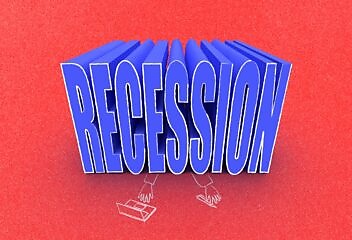If you’re a regular V-Blog reader, you’ll know we’ve been shouting at anyone who’ll listen calmly discussing the recession and its impact on the marketing world.
Alanna wrote a great post exploring how recessions can unleash a slew of unhelpful stakeholder feedback — and what you can do about it.
It got me thinking about another crucial part of the process: how creative ideation changes in a recession.
Because when you’re dealing with feedback on a piece of work, there’s a tangible thing you can have an arm wrestle over. But creative ideas are abstract by definition. Which means it takes trust in both the process and the practitioners to take something from pitch to production.
Trouble is, the recession anxiety stakeholders are dealing with right now is kryptonite for creative confidence.
So how do you, as a creative marketer, steward anxious stakeholders through the creative ideation process? How can you get to quality work that’s actually going to have the impact that stakeholders so desperately crave right now?
Well, this is by no means a tri-headed silver bullet — but here are three fundamental things you can do to aid that process.
#1. Beware the path of least resistance
There’s a lot on the line for everyone right now — living costs, job security, economic uncertainty — to name but a few. Stakeholders might not admit it (they might not even realize it) but they’re probably a little scared.
And when you’re pitching a creative idea in a recession, you probably are too.
Fear and uncertainty screw with our brain chemistry. When we’re scared, our prefrontal cortex essentially shuts down — which short-circuits our ability to think strategically.
And in this hyper-alert state, the brain’s survival instincts default to “familiar: good”, “unfamiliar: bad”.
The result? Marketing ideas that might be received as novel or innovative in ‘peacetime’ can suddenly seem dangerous or reckless in a recession.
But what’s safe is seldom creative or impactful — and vice versa. So counterintuitively, the caution you’re exercising because it feels safer, is actually the bigger risk in marketing terms.
In this case, by taking the path of least resistance and just giving stakeholders ‘what they want’ — you’re effectively letting them down right when they need a steady hand the most.
So what can you do about it?
Get much better at advocating for the unfamiliar.
And no, that doesn’t mean running towards unnecessary risk. But it does mean helping your stakeholders process their risk aversion while finding ways to mitigate your own fear-based decision-making.
There are a number of ways you can practically execute this. One is presenting people with a scale of options: ‘safe’ to ‘moderate’ to ‘brave’ — seeding your preferred route as the ‘moderate’ option. This will not only demonstrate that your suggestion is considered, it’ll also give your stakeholders a reference point from which to judge the ‘extremeness’ of the idea.
People like choice. This method allows stakeholders to feel like they’ve been responsible and gives the most creative ideas the best chance of survival.
Just make sure your ‘safe’ and ‘brave’ routes are viable options that won’t crush your soul to execute — because they might end up as in the top spot.
#2. Don’t train stakeholders to be untrustworthy
As marketers we know that the rationale behind a creative idea is just as important as the idea itself.
In fact, it might actually be more important. Creative ideas are subjective, but good rationale should feel like an irrefutable synthesis of factors that lead to a logical conclusion.
And that’s exactly why it’s so easy to over-explain — especially in a recession, where certainty is at a premium.
Because when you feel the reflected fear of your stakeholders — it can make you doubt the ideas you’re putting forward.
So to signal confidence and show how much work has gone into a piece (both to the stakeholder and yourself), we can start to load our pitch decks with creative justification for just about every keystroke we’ve made.
But the result is often the polar opposite of the outcome we wanted.
Why? Because just like liars tend to pack their stories with unnecessary details (because it feels like substance), by over-explaining your ideas you begin to erode, rather than build, confidence. In fact, you might even start to make great work look like wooly creative concepts that need a cart-load of caveats to carry them.
The way out of this death roll? Ask yourself “is that annotation for them…or for you?”
This question can be a key step to rediscovering your ability to deliver work that’s researched, justified, and detailed — but not neurotically forensic.
As a by-product, it’ll help you see far more clearly which ideas are actually rooted in enough evidence to stand on their own… and which ones are kinda reliant on the over-explanation in order to function.
#3. Don’t go for quick wins at the expense of long-term success
Recession fear cuts both ways — and nowhere is this more apparent than in the recession-driven swing from brand awareness to sales activation.
Recession anxiety can (ironically) cause quality standards to slip — precisely because people default to safe thinking. The success criteria changes from “What’s the best solution to this problem?” to “What’s likely to get approved?”. Likewise, stakeholders start to think “How can I justify this to the CFO” instead of “What is the best outcome we could reach here?”.
This happened with a client recently. Between us we unintentionally slipped into safety mode, patted each other on the back, and pushed brand awareness to the bottom of the agenda.
And that’s really counterproductive. Because it’s super important for businesses to grow their brand in a downturn — especially the current one.
When the post-pandemic economic bubble burst, the number of IPOs in the U.S dropped from a record 1035 in 2021, to just 181 in 2022. Maybe investors got more conservative. Maybe there’s a building mass of startups waiting for better market conditions to go public.
Either way, things are relatively quiet now. And it’s cheaper (and less competitive) to make noise when markets slow down. When optimism creeps back into the market, it’s going to be harder to stand out than it is today.
To guide your stakeholders through that, as a creative marketer you’ll need to cultivate a ‘campaign mindset’ which will ensure you see value from the moves you make right now.
This isn’t just saying “spend loads of money on brand” (as nice as that would be). You’re saying, “now’s a good time to invest in brand building, so long as we’re intentional about the next steps in the journey that these brand building moves will kickstart”.
Put it this way: companies in stable markets never regret prior investments in brand.
So, in a nutshell…
When the recession fear hits, stakeholders will look to you for confidence, guidance, and clarity by way of increased creative scrutiny.
If you’re the creative marketer on a project it’s really important you admit your fear, respect the fear that stakeholders have, recognize how it might be influencing both of your decision-making, and take steps to mitigate it so you don’t inadvertently make things worse.
By maintaining your role as strategic advisor, being well researched but not neurotic, and fostering a campaign mindset — you’ll not only be able to keep delivering your best for your stakeholders in a recession.
You might just emerge from it a better marketer.

Enjoyed this article?
Take part in the discussion








Comments
There are no comments yet for this post. Why not be the first?